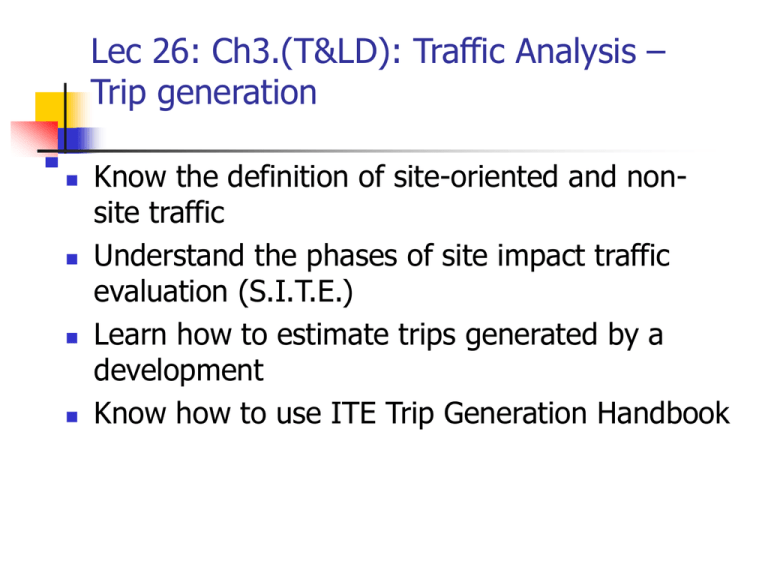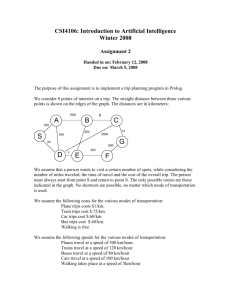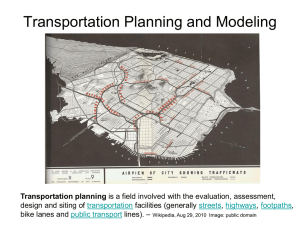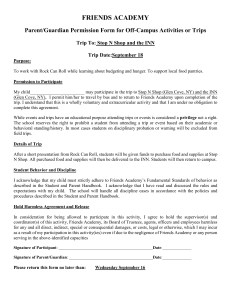Traffic analysis - trip generation
advertisement

Lec 26: Ch3.(T&LD): Traffic Analysis – Trip generation Know the definition of site-oriented and nonsite traffic Understand the phases of site impact traffic evaluation (S.I.T.E.) Learn how to estimate trips generated by a development Know how to use ITE Trip Generation Handbook Site-oriented traffic vs. Non-site traffic Site-oriented traffic (trips having an OD on the site With the development (new or existing) Non-site traffic (no OD on the site) Without the development “SITE” Methodology Phase I: Establish existing traffic conditions without the site (proposed) Phase II: Forecast future traffic conditions without the site Phase III: Forecast future site-only traffic conditions Phase IV: Determine total future traffic conditions (II + III) Phase V: Evaluate alternative improvements Phase VI: Negotiations Phase VII: Implementation Flow chart of SITE process Phase I Phase II Input from MPO and local/state agencies Existing Background Traffic Calculate LOS Traffic growth factors Future background traffic w/o site Forecast traffic for other new adjacent sites Combine Calculate LOS Compare Flow chart of SITE process (cont) Phase III Forecast traffic for site development Phase IV Combine Total traffic Calculate LOS Compare Flow chart of SITE process (cont) Phase V Develop alternative solutions Evaluate solutions Document findings Feedback Phase VI Begin negotiations between local officials and developers Perform supplemental technical analyses Feedback Phase VII Assist in preparing construction plans Implementation Site-oriented traffic (site-generated trips): much easier to estimate because… The land use activities are known The number of trips expected to be generated by the proposed development can be determined using the ITE Trip Generation Handbook The present and future directional distribution can be estimated 5 Primary characteristics The total number of trips generated The number of trips to and from the site during the peak hours of the adjacent street The number of trips to and from the site during the peak(s) of the generator Daily variation Monthly variation Unit used as the base variable for tripgeneration rates Be functionally related to the volume of traffic generated (e.g. 48 trip ends per 1000 sq.ft floor area, 5.7 trip ends per occupied dwelling unit) Be relatively easy to establish/measure (meaning easy to measure the size, like size of an household, size of a store) Provide consistent and transferable rates (Although variations exist, establishments of similar characteristics have similar trip generation rates. (See the handout) Issues (pp. 29, 39, 40) Age of data base – Not much difference between old and new data Daily variations – Peaking of traffic varies depending on the type of development Location variation – ITE trip generation data came from suburban areas (for vehicular trips) Pass-by traffic – Some generators attract traffic from the passing traffic stream Mixed-use development – Mixed-use land may produce less trips than the sum total of individual land uses (many rates are derived from standalone developments) Vehicular trips – The generation rates are vehicular trips for “average” vehicle occupancy Variability in rates – variation in data Sample size – Some have only a small number of samples Pass-by Traffic Land use activities such as offices, industrial parks, hotels, high-quality restaurants, and residential development generate traffic which intends to have a trip end at the particular site and therefore constitute new traffic on the street system. However, a sizable portion of the traffic generated by fast-food restaurants and gas stations is already on the adjacent street and merely stops at the establishment in passing by I.e. pass-by traffic. They are NOT new traffic. They were there but because a new establishment was developed, they just decided to make a detour. See Table 3-4 for variation of the amount of pass-by traffic by generator type and size, and Table 35 for daily variation, and Table 3-6 for weekly variation Mixed-use development When an activity center is developed with a mix of different land uses (e.g., retail and office), there are fewer trips on and off the site than if the retail and office activities are developed on separate sites. In a mixed-use development, some individuals will complete two or more purposes without leaving the site. Shopping center (See Table 3-7 and 3-8) Satellite development Regional shopping centers attract other commercial retail developments to property surrounding the center. The interaction (shared trips) may be 10% or more of the traffic generated by a satellite development. The number of shared trips will be subtracted when it is loaded to the external roadway. Note: this is not a chained-trip. A chained trip is a trip that combines different trip purposes (work, shop, day-care drop off, etc.).





